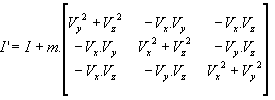About Notations Used for Inertia Matrices | ||
| ||
Moments and Products of 3D Inertia
|
Iox |
Moment of inertia of the object about the ox axis: |
|
|
Ioy |
Moment of inertia of the object about the oy axis: |
|
|
Ioz |
Moment of inertia of the object about the oz axis: |
|
|
Pxy |
Product of inertia of the object about axes ox and oy: |
|
|
Pxz |
Product of inertia of the object about axes ox and oz: |
|
|
Pyz |
Product of inertia of the object about axes oy and oz: |
|
(where M is the mass of the object; units: kg.m2)
![]()
Moments and Products of 2D Inertia
|
Iox |
Moment of inertia of the surface about the ox axis: |
|
|
Ioy |
Moment of inertia of the surface about the oy axis: |
|
|
Pxy |
Product of inertia of the surface about axes ox and oy: |
|
(where A is the surface; units: m4)
![]()
Matrix of Inertia
| 3D Inertia: | 2D Inertia: |
|---|---|
 |
|
where I is the matrix of inertia of the object with respect to orthonormal basis Oxyz
![]()
Moments and Principal Axes
The matrix of inertia being a real matrix (whose
elements consist entirely of real numbers) and a symmetric matrix,
there exists an orthonormal basis of vectors
![]() in this matrix of inertia.
in this matrix of inertia.

The principal axes are defined by vectors
![]() and inertia principal moments are expressed by
and inertia principal moments are expressed by
![]()

Note:
![]() is an orthonormal direct basis.
is an orthonormal direct basis.
Expression in Any Axis System
I is the matrix of inertia with respect to orthonormal basis Oxyz.
Huygen's theorem is used to transform the matrix
of inertia:
![]() (parallel axis theorem).
(parallel axis theorem).
Let I' be the matrix of inertia with respect to
orthonormal basis Pxyz where
![]()

M = {u,v,w}: transformation matrix from basis (Pxyz) to basis (Puvw) TM is the transposed matrix of matrix M.
J is the matrix of inertia with respect to an orthonormal basis Puvw:
J = TM.I'.M
![]()
Additional Notation Used in the Measure Inertia Command
Ixy = (-Pxy)
Ixz = (-Pxz)
Iyz = (-Pyz)
Note: Since entries for the opposite of the product are symmetrical, they are given only once in the dialog box.
|
IoxG |
Moment of inertia of the object about the ox axis with respect to the system Gxyz, where G is the center of gravity. |
|
IoxO |
Moment of inertia of the object about the ox axis with respect to the system Oxyz, where O is the origin of the document. |
|
IoxP |
Moment of inertia of the object about the ox axis with respect to the system Pxyz, where P is a selected point. |
|
IoxA |
Moment of inertia of the object about the ox axis with respect to the system Axyz, where A is a selected axis system. |
|
etc. |